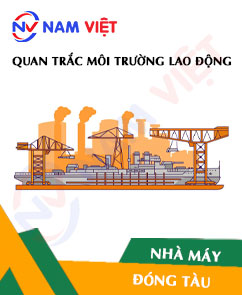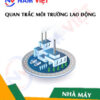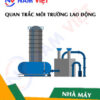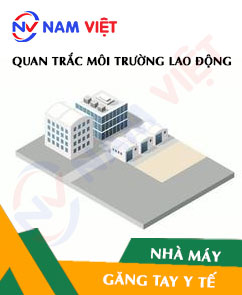Occupational Environment Monitoring at Shipbuilding Factory
99,000 ₫
Note: The above price is calculated for one sample; the price may fluctuate depending on the area of the environment to be monitored and market movements. For more accurate pricing support, please refer to the price list or contact our consulting staff directly.
Environmental monitoring of a shipbuilding factory is a session of collecting, analyzing, and evaluating factors at the workplace that may be harmful to workers’ health.
Table of Contents
Toggle1. Overview of Shipbuilding Factories
a. What is a shipbuilding factory?
A shipbuilding factory is a manufacturing facility specialized in constructing and assembling ships. This is where workers and engineers collaborate to produce commercial ships, warships, fishing vessels, and other types of ships according to customer requirements.
In a shipbuilding factory, the ship production process typically includes stages such as design, metal cutting and welding, electrical and mechanical system assembly, modification, and finishing. Ships are usually built on an assembly line, where different parts of the ship are processed at separate workstations within the factory.
Shipbuilding factories are often equipped with modern technologies and machinery to ensure optimal quality and production efficiency. Professional engineers and workers in the shipbuilding industry work together to build safe, reliable ships that meet international standards.

b. Production stages in shipbuilding factories
Production stages in shipbuilding factories may vary depending on the scale and type of ship being constructed. However, the following are common steps in the ship production process:
- Design: This stage includes determining customer requirements, technical analysis, and detailed ship design. Engineers and designers create technical drawings and 3D models to develop production plans.
- Material preparation: Materials such as steel, aluminum, and composites are prepared and cut into ship components according to technical drawings. Steel cutting is often performed using plasma or laser cutting to ensure high precision and accuracy.
- Welding: Ship components are welded together to form the main structure of the ship. Welding methods may include arc welding, CO2 welding, or laser welding. Welders must follow safety and quality standards to ensure a strong and reliable structure.
- Assembly: Ship components, including steel structures, electrical systems, mechanical systems, ventilation systems, water systems, and other equipment, are assembled and attached to the main ship structure. This process uses tools and equipment such as cranes, forklifts, and drive systems to ensure accurate and efficient assembly.
- Finishing: Once the ship is assembled, it undergoes final finishing steps, including painting, installing electronic systems, quality inspections, and interior completion. This final stage ensures the ship is fully complete, meets regulatory requirements, and is ready for testing and delivery.

c. Shipbuilding factories in Vietnam
In Vietnam, there are many shipbuilding factories of varying scale and production capacity. Some notable shipbuilding companies include:
- Thanh Long Shipbuilding Industry One Member Limited Company
- Phà Rừng Shipbuilding One Member Limited Company
- Saigon Shipbuilding Industry One Member Limited Company
- Ha Long Shipyard
- Bach Dang Shipbuilding Industry Corporation
- Hyundai Vinashin Shipyard Limited Company
- Nam Trieu Shipbuilding Industry Company
- Dung Quat Shipbuilding Industry Company
- Ba Son Corporation
- Vietnam Shipbuilding Industry Corporation

d. Occupational diseases that may occur for shipyard workers
Working in a shipyard can expose workers to certain occupational diseases. Some common occupational diseases in the shipbuilding industry include:
- Metal fume-related diseases: Workers involved in welding and grinding may be exposed to metal fumes such as manganese, lead, cadmium, nickel, and other compounds. Inhaling these fumes can cause manganism, cardiovascular diseases, and neurological issues.
- Skin diseases: Contact with chemical compounds during painting, cleaning, and maintenance can cause skin diseases such as dermatitis, allergies, and burns.
- Respiratory diseases: Workers may be exposed to metal dust, chemical fumes, and other toxic substances, which can lead to asthma, pneumonia, and pleural diseases.
- Hearing-related issues: Noise is common in shipyards, especially during welding and repair activities. Workers may face hearing loss and other noise-induced conditions.
- Spinal and joint disorders: Lifting, pulling, and moving heavy components during assembly and repair can cause strain and injuries to the spine and joints.
To mitigate these risks, safety measures such as using personal protective equipment, proper chemical and waste management, noise control, and worker safety training are essential in the shipbuilding industry.

e. Common types of ships worldwide
There are many common types of ships worldwide, each designed for different purposes. Some popular types include:
- Cargo ships: Used for transporting goods across seas, including container ships, bulk carriers, tankers, gas carriers, and refrigerated cargo ships.
- Cruise ships: Designed for tourism and entertainment services for passengers, with amenities such as cabins, restaurants, golf courses, swimming pools, casinos, and performance stages.
- Passenger ships: Used for transporting passengers, including ferries, sea cruises, high-speed ferries, and yachts.
- Warships: Used by the military for defense and combat, including cruisers, destroyers, submarines, and aircraft carriers.
- Fishing vessels: Used in the fishing industry for harvesting and processing seafood, such as trawlers, longliners, and purse seiners.
- Research vessels: Used for scientific research and exploration, conducting oceanographic, geological, ecological, and meteorological studies.
- Oil and gas carriers: Used for transporting oil and gas from production sites to ports, including VLCCs (very large crude carriers) and LNG carriers.
2. Overview of Occupational Environmental Monitoring Services
a. What is occupational environmental monitoring in shipbuilding factories?
Occupational environmental monitoring in shipbuilding factories is the activity of collecting, assessing, and analyzing measurements of workplace environmental factors to implement timely measures, minimize environmental hazards to workers’ health, and prevent occupational diseases. Occupational environmental monitoring is a mandatory requirement for shipbuilding factories.
Occupational environmental monitoring plays a crucial role in protecting, maintaining, and enhancing workers’ health, as the workforce is the primary resource generating profit for a business. Workers regularly exposed to risk factors or occupational hazards beyond permissible limits may suffer health effects and occupational diseases.
REGISTER FOR OCCUPATIONAL ENVIRONMENT MONITORING SERVICE
b. Nam Viet’s occupational environmental monitoring program
Nam Viet’s occupational environmental monitoring program is developed by engineers specializing in occupational safety and environmental protection. To ensure workers’ health and safety, the program uses modern measurement methods to monitor air, water quality, microclimate, physical factors, dust, and other workplace hazards. This program is essential for providing a safe working environment and protecting workers’ health.
Additionally, Nam Viet’s program plays an important role in researching and developing solutions to improve workplace environmental quality. With the dedication and professionalism of its monitoring team, Nam Viet’s exclusive program has become a breakthrough in occupational safety management and environmental protection in Vietnam.

c. Standardization in occupational environmental measurement procedures
Standardization in Nam Viet’s occupational environmental measurement procedures is critical to ensuring accurate and reliable results. To guarantee precision, the program follows standards and procedures recognized by the Ho Chi Minh City Department of Health. This ensures collected data is highly reliable for evaluating workplace environments and making decisions to improve working conditions and protect workers’ health.
These standardized procedures also ensure measurements are conducted by highly qualified monitoring specialists with years of experience, allowing managers and experts to trust Nam Viet’s results and make informed decisions for worker and environmental safety.
By applying standardization in measurement procedures, Nam Viet demonstrates its commitment to providing a safe working environment and protecting workers’ health while contributing to the development and enhancement of occupational safety and environmental management in Vietnam.
d. Occupational environmental monitoring report for shipbuilding factories
Monitoring results are prepared according to Form No. 04, Appendix III issued with Decree 44/2016/ND-CP and prepared in two copies: one sent to the contracting workplace and one retained by the monitoring organization.
The retention period for occupational environmental monitoring results is unlimited according to legal regulations.

e. Frequency of occupational environmental monitoring according to law
According to Clause 2 of Article 18, Law on Occupational Safety and Hygiene 84/2015/QH13, employers must conduct occupational environmental monitoring to assess harmful factors at least once a year.
f. Deadline for submitting occupational environmental monitoring reports according to law
The submission deadline is before December 31 each year. Enterprises must submit occupational environmental monitoring reports to the local Department of Health where the business is headquartered and where workers are employed.
When there are changes in production technology or processes, or when upgrading facilities that may introduce new hazards, enterprises must update occupational hygiene records related to harmful factors requiring monitoring.
g. Penalties for violations of occupational environmental monitoring by employers
According to Article 27 of Decree No. 12/2022/ND-CP dated 17/01/2022 on administrative penalties in labor, social insurance, and Vietnamese workers working abroad under contracts:
- Clause 2: Fines of 2,000,000 – 5,000,000 VND for employers who fail to publicly disclose monitoring results to workers at the monitoring site and management areas immediately after results are available.
- Clause 3: Fines of 20,000,000 – 40,000,000 VND for employers who do not conduct occupational environmental monitoring to control health hazards to workers according to the law.
- Clause 4: Fines of 40,000,000 – 60,000,000 VND for employers who collude with monitoring organizations to commit fraud in occupational environmental monitoring, but not to the extent of criminal liability.
3. Harmful Environmental Factors for Workers in Shipbuilding Factories
Workers in shipbuilding factories may be exposed to harmful environmental factors. Below are some potential environmental factors in the shipbuilding industry that can affect workers’ health:
- Chemical fumes: Processes such as painting, cleaning, and using other chemical compounds in shipbuilding factories can generate toxic chemical fumes. Inhaling these fumes can irritate the respiratory system, affect the nervous system, and cause other health issues.
- Dust and particles: Welding, grinding, cutting, and repairing ships can generate metal dust, particles, and other irritants. Inhaling dust and particles can cause respiratory problems such as pneumonia, asthma, and other respiratory diseases.
- Noise: Work in shipbuilding factories is often associated with high noise levels, especially during welding and repair. Prolonged exposure to high noise can cause hearing loss and other accident-related issues.
- Temperature and humidity: Shipbuilding tasks frequently involve exposure to high or low temperatures and high humidity. Such harsh environmental conditions can cause health problems such as heatstroke, sunstroke, and humidity-related illnesses.
- Fire and explosion risks: During welding, cutting, and painting, there is a risk of fire and explosion due to the interaction of liquids, vapors, gases, and other flammable materials. Special attention and safety measures are required to prevent accidents and explosions.
- Other physical factors: Factors such as vibrations, UV (ultraviolet) radiation, X-rays and gamma rays, and pollutants from engines and machinery can also affect workers’ health in shipbuilding factories.
REGISTER FOR OCCUPATIONAL ENVIRONMENT MONITORING SERVICE
4. Measures to Improve the Work Environment in Shipbuilding Factories
Improving the working environment in shipbuilding factories is essential to ensure workers’ health and safety. Below are some measures that can be applied to enhance the work environment in the shipbuilding industry:
- Provide information and training: Give workers full information about harmful environmental factors, risks, and safety measures. Train workers on using personal protective equipment, safe work procedures, and waste management.
- Waste management: Implement effective waste management measures to reduce workers’ exposure to pollutants. Properly handle and dispose of waste according to relevant regulations and laws.
- Adjust work processes: Modify work procedures to minimize exposure to harmful environmental factors. Use technical safety measures such as effective ventilation systems, dust extraction systems, and fire-resistant materials.
- Noise control: Apply noise control measures such as isolating noisy tasks, using ear protection, and ensuring compliance with safe noise limits.
- Monitoring and evaluation: Conduct regular monitoring and evaluation of the work environment to identify issues and adjust safety measures as needed. Ensure compliance with government and international safety and environmental regulations.
- Encourage safety awareness and incident handling: Foster a safety-oriented workplace culture, encouraging workers to participate in improving the work environment and reporting hazardous environmental incidents.
- Ensure compliance with safety regulations and procedures: Follow safety regulations and procedures related to the shipbuilding industry, including using personal protective equipment, implementing safe work processes, and protecting workers’ health.
- Regularly conduct occupational environment monitoring in factories, collect and analyze harmful factors affecting workers, and adjust to reduce risks to prevent occupational diseases.
5. Benefits of Regular Monitoring in Shipbuilding Factories
An Toàn Nam Việt provides businesses with excellent benefits when using occupational environment monitoring services according to Decree 44/2016/NĐ-CP on the management and control of harmful factors in the workplace affecting employees.
- Businesses can proactively control harmful factors in workshops or factories.
- Receive recommendations on measures to reduce harmful factors and improve the work environment quality.
- Indirectly protect human resources, a key factor in business development.
- Minimize the impact of occupational diseases on workers’ health, reducing future treatment costs.
- Improved worker health leads to better product quality and ensures stable production output.
- Ensure compliance with labor safety laws, avoiding legal risks.
- Enhance credibility and professionalism, thereby elevating the company’s brand.
Nam Viet’s environmental monitoring service is a solution to minimize occupational disease risks, contributing to a clean and high-quality work environment.

6. Nationwide Occupational Environment Monitoring Center
Nam Viet Occupational Environment Monitoring Center is a professional unit specializing in monitoring and measuring workplace environmental quality throughout all provinces of Vietnam. With an experienced team of environmental monitoring specialists, the center uses modern measuring equipment to ensure accuracy and reliability.
In addition to providing monitoring services, the center assists clients in planning, managing, and following up on occupational environment issues. With the motto “customer-centered,” the center prioritizes client satisfaction, meets all client needs, and commits to providing the best solutions.
REGISTER FOR OCCUPATIONAL ENVIRONMENT MONITORING SERVICE
With investments in technology, equipment, and human resources, Nam Viet’s monitoring center has become a reputable unit in occupational environment monitoring in Ho Chi Minh City, with the following goals:
- We value brand reputation and the quality of our service products.
- We provide clients with the best and most suitable solutions.
- With a team of experienced Masters and Engineers committed to protecting the environment and benefiting businesses.
- Clients of Nam Viet Environmental Monitoring will receive professional services from experts in the field, as well as the best cost advantages.
The occupational environment monitoring process at Nam Viet includes the following steps:
- Before monitoring, ensure all equipment is calibrated and adjusted according to legal regulations.
- Carry out the monitoring process as committed to the Department of Health.
- Report accurate monitoring results to employers.
- If monitoring results indicate unsafe conditions for workers, Nam Viet will provide corrective solutions, and the factory will implement:
- Implement measures to improve working conditions, minimizing harmful factors and preventing occupational diseases.
- Organize medical check-ups to detect occupational and work-related illnesses early for employees in unsafe work environments.
- Provide compensation in kind for workers according to labor law regulations.

7. Occupational Environment Monitoring Price List
To help businesses conduct professional and effective occupational environment monitoring, Nam Viet provides clients with a detailed and reasonably priced service price list.
- Our price list provides detailed information on the costs of all monitoring services, including transportation, measurement, analysis, and reporting. Clients can be confident in the accuracy and reliability of the monitoring reports provided.
- We are committed to offering competitive and reasonable prices while providing prompt and professional consultation on any service-related inquiries.
- With Nam Viet’s price list, clients can easily select services that best meet their needs. We guarantee maximum satisfaction with professional service quality.
1 review for Occupational Environment Monitoring at Shipbuilding Factory
No comments yet












maituyet.cuong12
Good labor environment monitoring service!